Homes for Heroes - Times Past

In partnership with the Glasgow Times, our archivists are exploring Glasgow's fascinating history. This week, Irene O'Brien writes about Glasgow's 'Homes for Heroes' after World War I.
The First World War had changed politics and a consensus emerged about the need for a national housing policy. This was addressed in the immediate aftermath of the First World War. Housing was a major issue during the war and in line with Lloyd George’s promise during the 1918 election to provide ‘Homes for Heroes’, an Act of 1919 required local authorities to provide working class housing with government subsidies. Glasgow estimated a need for 57, 000 new houses in the aftermath of the war to deal with its acute overcrowding problem.
In Glasgow, a number of municipal "schemes" quickly emerged on undeveloped ground in Glasgow. The earliest, including Riddrie, Mosspark, and Knightswood were built under the Ordinary scheme. This was a bit of a misnomer as these were the elite in Glasgow housing stock, and with high rents, rarely housed the working classes.
Built between 1920 and 1927 on open fields to the west of Cumbernauld Rd, Riddrie was the first one of the housing schemes. There was a mixture of semi-detached and terraced cottages with gardens and three-storey tenement flats. All the houses had cavity walling and electric servicing, an innovation at the time. Around 1, 000 houses were built, but most of them were allocated to skilled workers earning above-average wages.
Mosspark, built in 1924, was elite in terms of Glasgow housing stock in the inter-war period. It had a generous subsidy, but its rents were kept high by the local Scottish Office’s insistence on economic rents. Houses were allocated to ‘respectable’ professional or white-collar workers.
Knightswood was Glasgow’s largest housing scheme when it was built, with a total of 6, 714 houses. The land was purchased from the Summerlee Iron Co. in 1921, and the Council set about building a garden suburb. The buildings included semi-detached, terraced and cottage flats, all limited to two storeys. Provision of amenities often lagged behind the building of houses in Glasgow housing schemes, but Knightswood fared better than many other areas. The Corporation acquired 148 acres for Knightswood Park in 1929. In addition to the two bowling greens and four tennis courts, the park included a golf course, pitch and putt course, boating pond, running track and cricket pitch. Four new shopping centres, eight churches and six schools were also provided.
